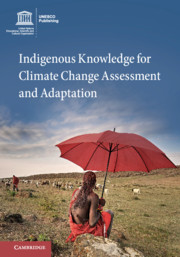Book contents
- Indigenous Knowledge for Climate Change Assessment and Adaptation
- Indigenous Knowledge for Climate Change Assessment and Adaptation
- Copyright page
- Contents
- Contributors
- Foreword
- Acknowledgements
- Abbreviations
- 1 Indigenous Knowledge for Climate Change Assessment and Adaptation: Introduction
- Part I Knowing our Weather and Climate
- 2 Forest, Reef and Sea-Level Rise in North Vanuatu: Seasonal Environmental Practices and Climate Fluctuations in Island Melanesia
- 3 Annual Cycles in Indigenous North-Western Amazon: A Collaborative Research Towards Climate Change Monitoring
- 4 Indigenous Knowledge in the Time of Climate Change (with Reference to Chuuk, Federated States of Micronesia)
- 5 Local Responses to Variability and Climate Change by Zoque Indigenous Communities in Chiapas, Mexico
- 6 Climate Knowledge of Ch’ol Farmers in Chiapas, Mexico
- Part II Our Changing Homelands
- Part III Confronting Extreme Events
- Part IV Sources of Indigenous Strength and Resilience
- Index
- References
3 - Annual Cycles in Indigenous North-Western Amazon: A Collaborative Research Towards Climate Change Monitoring
from Part I - Knowing our Weather and Climate
Published online by Cambridge University Press: 13 September 2018
- Indigenous Knowledge for Climate Change Assessment and Adaptation
- Indigenous Knowledge for Climate Change Assessment and Adaptation
- Copyright page
- Contents
- Contributors
- Foreword
- Acknowledgements
- Abbreviations
- 1 Indigenous Knowledge for Climate Change Assessment and Adaptation: Introduction
- Part I Knowing our Weather and Climate
- 2 Forest, Reef and Sea-Level Rise in North Vanuatu: Seasonal Environmental Practices and Climate Fluctuations in Island Melanesia
- 3 Annual Cycles in Indigenous North-Western Amazon: A Collaborative Research Towards Climate Change Monitoring
- 4 Indigenous Knowledge in the Time of Climate Change (with Reference to Chuuk, Federated States of Micronesia)
- 5 Local Responses to Variability and Climate Change by Zoque Indigenous Communities in Chiapas, Mexico
- 6 Climate Knowledge of Ch’ol Farmers in Chiapas, Mexico
- Part II Our Changing Homelands
- Part III Confronting Extreme Events
- Part IV Sources of Indigenous Strength and Resilience
- Index
- References
- Type
- Chapter
- Information
- Publisher: Cambridge University PressPrint publication year: 2018



